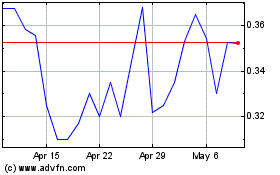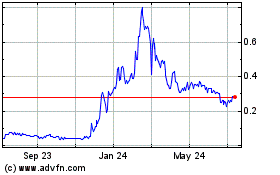Hay Mountain Project Update: Added Targets, New Discoveries, and Innovative In-Hole Assay Done While the Drill Turns
February 24 2015 - 10:37AM
Business Wire
Liberty Star Uranium & Metals Corp. (“Liberty Star” or
the “Company”) (OTCQB: LBSR) is pleased to announce that three
technical breakthroughs have occurred at the Hay Mountain Project
over the last three months. These are:
1. Additional targets
2. The potential for leachable oxide copper
bodies
3. The ability to separate diamond core drill
cuttings using a centrifuge so that cuttings can be separated into
samples corresponding to drill core intervals or fractions of those
intervals at any depth desired as the drill turns without waiting
for the core to be removed from the hole. Then x-ray fluoresce
analyzers will be used to analyze these samples for an approximate
assay in the field as the drill turns.
Liberty Star’s CEO/Chief Geologist elaborates point by
point:
1. “Working with geologist Dr. S. Skirvin
using geologic information systems (GIS) mapping tools, we
clarified the geophysical relationships so that the geophysical
data (ZTEM- electromagnetics and magnetics) for the Hay Mountain
Project area could be related to culture on topographic maps, and
recently produced high resolution space imagery, leading to the
detection of significant number of additional targets
2. “We have also evaluated the surrounding
copper and precious metal mines including Arizona’s Tombstone,
Bisbee (historic and future Cochise ore body), Johnson Camp, I-10
Porphyry Gunnison- Excelsior, Safford, Morenci, Rosemont, Florence,
Twin Buttes: New Mexico’s Tyrone mine, Mexico’s La Caridad, and
Cananea, and many others, which all have oxide copper recovery
units (Solvent Extraction-Electrowinning plants (SX-EW plants)).
Most porphyry copper deposits in the southwest USA, Mexico, Latin
America and other geologically similar areas have a green and black
copper oxide cap or periphery as a result of their oxidizing
history details dependent on rock type and other factors. Hay
Mountain is easily compared to Bisbee, Nord Resources Corporation’s
Johnson Camp and the Gunnison Copper Project (Excelsior Mining
Corp), nearby where the same package of layered altered and
mineralized rocks exists, as does a profound magnetic anomaly
(Gunnison and Hay Mountain and others). Gunnison has disseminated
oxides that can be treated by in situ (Latin: in place) leaching.
Excelsior has done extensive testing and design of a proposed in
situ leach operation that suggests an internal rate of return of
about 45% and a payback in 2.5 years using a projected $2.75 copper
price. (Pg. 246 Gunnison Copper Project: NI 43-101 Technical Report
Prefeasibility Study). We have
encountered more shallow outcrops containing green and what appears
to be black copper oxide at Hay Mountain. Also, the horizontal tops
of the recorded magnetic signals suggest the top of an oxide zone
that compels us to consider that a large, near surface body of
oxide copper may be located above the large sulfide targets which
are more easily detected by ZTEM (electromagnetic, and magnetic)
geophysics. The same host rock sediments are present at Johnson
Camp, Gunnison, Bisbee and Hay Mountain. These rocks can be
selectively mined using a Vermeer Terrain Leveler, resulting in
lower cost mining and ore grade selection than standard methods of
open pit mining. I have already had tests run at the Vermeer
laboratories on ore material of each of the various sedimentary
copper bearing units at Johnson Camp to see if the Vermeer can cut
these altered and mineralized sediments. The results demonstrate
that the Vermeer machinery can readily cut these units. Contacts
between low and high grade can be followed to within 6 inches
horizontal and a couple of inches vertically. Fragmentation
achieved by the Vermeer concentrates on the ore bearing interstices
of the host rock, thus maximizing the proportion of exposed surface
area of the fragmented material that is ore bearing. This feature
yields materials that may be much more available for solvent
dissolution than conventionally crushed ore. The cut can be
adjusted to get the optimum fragment size for heap leaching: all of
this without using drilling or blasting. Thus, if we intersect
significant amounts of leachable oxide copper mineralization at a
shallow depth, which, as stated above, all surrounding porphyry
copper mines have, we will immediately go into an evaluation mode.
Nothing is definite until drills define such an oxide mineral body,
but these types of deposits could go into production at a low cost,
and quickly: in the range of 4 years (See pg. 249 Excelsior’s
43-101). The mining method at Hay Mountain could be open pit, heap
leach or in situ like that planned at the Gunnison Copper
Project.
3. “We will be using some advanced equipment
in the drilling program which will make Phase 1 drilling proceed
faster, more controlled, accomplished more accurately, and data
gathered very quickly. This will be a Solids Removal Unit (SRU),
developed by an Australian company and sold in the USA (see
http://www.amcmud.com/en/products-range/equipment-rental/product-data-sheets.html).
i. This device uses a centrifuge to remove
drill cuttings from the mud circulation that cools the diamond bit
and carries cuttings to the surface.
ii. The SRU removes +99% of drill cuttings
from the mud and then circulates the cleaned mud back down the
hole.
iii. The cuttings are ejected from the SRU
where they can be bagged and disposed of.
iv. This give us the opportunity to sample
the drill cuttings at any interval we choose – say 2.5, 5, 7.5 or
10 feet – or all of those intervals through the length of the drill
hole or whatever intervals are desired to determine what the
diamond drill is cutting even before the core is extracted, by
“assaying” using a modern XRF (X-Ray fluorescence) unit:
www.niton.com either a hand held “gun” or a more powerful bench or
pick-up tail gate style unit. While an XRF is not a true “assay”
used for exact grade determination for ore calculations it is
sufficient for the onsite geologist to determine whether the gross
metals content is going up, down or remaining the same. This
information can be transmitted by computer to the Internet so all
senior management personnel can review the data if it is critical.
Standard drill core assays by a certified lab will still be
undertaken following standard procedures which can only be done
that involve a carefully monitored and controlled half sample split
of the drill core, prepared in a very clean sample prep lab, and
sent under chain of custody control to a certified lab, which we
will also do. However XRF is sufficient for the onsite geologist to
determine whether the gross metals content is going up, down or
remaining the same. This droll mud sampling methodology (but
without the use of the SRU) was reported by D.K.F. McLachlan, in
Mckinstry,H.E. – Mining Geology 1948 in the days when diamond
drilling was young and the diamond drill core bit tended to grind
up core that was soft, where the mineralized intervals were
encountered. It is still a valid technique when combined with the
SRU.
“The SRU also meets the requirements of the Arizona State Land
Department permits that require collection of drill cuttings and
disposal in permitted land fill.
All of this new data and our innovative techniques, as well many
other details will be used in the presentation in Manila,
Philippines March 2-3, 2015 by Director Brett Gross and myself
during a full day presentation to potential investors and mining
professionals.”
“James A. Briscoe” James A. Briscoe, Professional Geologist, AZ
CACEO/Chief GeologistLiberty Star Uranium & Metals Corp.
Forward Looking
Statements
Statements in this news release that are not historical are
forward looking statements. Forward-looking statements in this news
release include all our planned drilling program, planned
methodology and our planned use of equipment, partners or funding
sources, including without limitation our plan to commence Phase 1
drilling at Hay Mountain and define an economic body of
mineralization there; that geological conditions may allow for an
in situ leaching operation, or open pit heap leaching; that
discovery of such a leachable ore body, similar those enumerated
above, could result in a 4 year time line to production. Factors
which may delay or prevent these forward-looking statements from
being realized include: the failure of our proposals to be
accepted; we may not attract any partners or funding sources; we
may not be able to raise sufficient funds to complete our intended
exploration, keep our properties or carry on operations; and we may
encounter an inability to continue exploration due to weather,
logistical problems, labor or equipment problems or hazards even if
funds are available. Even if we find a partner, we may not be able
to reach agreement or carry out the development program as
contemplated. Despite encouraging data there may be no commercially
exploitable mineralization on our properties. Readers should refer
to the risk disclosures in the Company’s recent 10-K and the
Company’s other periodic reports filed from time to time with the
Securities and Exchange Commission.
Agoracom Investor
Relationslbsr@agoracom.comhttp://agoracom.com/ir/libertystarorLiberty
Star Uranium & Metals Corp.Tracy Myers, 520-425-1433Investor
Relationsinfo@LibertyStarUranium.comFollow Liberty Star Uranium
& Metals Corp. on Facebook , LinkedIn &
Twitter@LibertyStarLBSR
Liberty Star Uranium and... (QB) (USOTC:LBSR)
Historical Stock Chart
From Mar 2024 to Apr 2024

Liberty Star Uranium and... (QB) (USOTC:LBSR)
Historical Stock Chart
From Apr 2023 to Apr 2024
